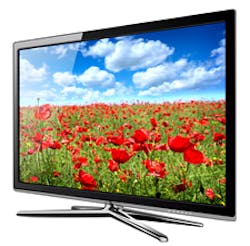Printed AMOLED TV display technology from DuPont gets Asian licensee
Wilmington, DE--DuPont signed a technology licensing agreement with a leading Asian manufacturer (rumored to be Samsung Mobile Display according to a November 3, 2011 Display Daily story from Ken Werner via Insight Media of Norwalk, CT) of active-matrix organic light-emitting diode (AMOLED) display products. The licensing agreement will enable process technology developed by DuPont to be used in the company’s production of large AMOLED television displays. DuPont says its AMOLED process technology enables large displays to be produced at significantly lower cost than alternative technologies such as liquid-crystal device (LCD) displays. Terms of the agreement were not disclosed.
"AMOLED televisions clearly represent the future. They are preferred by consumers for their superior performance, they are more energy efficient and the process technology we’re licensing allows them to be manufactured much more cost effectively," said David B. Miller, president, DuPont Electronics & Communications. "We look forward to helping make the promise of AMOLED television a commercial reality at a price point that is within reach for the mass consumer market."
DuPont says AMOLED displays also deliver vivid color, higher contrast, faster response, and a wider viewing angle than traditional LCD displays with less power consumption. AMOLED technology has been well received for small size displays such as in mobile phones, but cost has been a major barrier to the adoption of AMOLED technology for televisions up to this point. In response, DuPont developed a proprietary solution-based printing technology that efficiently dispenses liquid OLED materials that it has developed to optimize display yields and performance. The process is designed to significantly cut production costs for television-sized displays when compared to the current methods of producing AMOLED or LCD displays.
"Over the last several years, DuPont has used its substantial resources as a market-driven science company to solve significant technical challenges associated with the cost-effective manufacture of AMOLED displays. As a result, DuPont has developed a unique manufacturing process and innovative materials tailored to work with it," said William F. Feehery, global business director, DuPont Electronics & Communications. "By licensing display manufacturers to make AMOLED displays using DuPont process technology, we will also build a business selling proprietary DuPont OLED materials."
Based on industry estimates, the AMOLED television market is projected to grow to over $5 billion by 2017.
SOURCE: DuPont (November 2, 2011); http://onlinepressroom.net/DuPont/NewsReleases/
About the Author

Gail Overton
Senior Editor (2004-2020)
Gail has more than 30 years of engineering, marketing, product management, and editorial experience in the photonics and optical communications industry. Before joining the staff at Laser Focus World in 2004, she held many product management and product marketing roles in the fiber-optics industry, most notably at Hughes (El Segundo, CA), GTE Labs (Waltham, MA), Corning (Corning, NY), Photon Kinetics (Beaverton, OR), and Newport Corporation (Irvine, CA). During her marketing career, Gail published articles in WDM Solutions and Sensors magazine and traveled internationally to conduct product and sales training. Gail received her BS degree in physics, with an emphasis in optics, from San Diego State University in San Diego, CA in May 1986.
